Connectta Limited's Costing System: A Management Accounting Report
VerifiedAdded on 2022/11/17
|14
|3023
|164
Report
AI Summary
This report provides a comprehensive evaluation of the costing system and business operations of Connectta Limited, focusing on its job costing system. The analysis includes calculations for work-in-process inventory, finished goods inventory costs, and the determination of over-applied or under-applied overhead. The report explores two alternative accounting treatments for handling these overhead balances. Furthermore, it examines the deficiencies of the job costing system and highlights how an activity-based costing system could improve overhead cost allocation. The report emphasizes the benefits of activity-based costing in overcoming the limitations of traditional costing methods and making informed management decisions for future economic growth. The findings suggest that implementing activity-based costing would enable Connectta Limited to better allocate overhead costs and improve overall financial management.
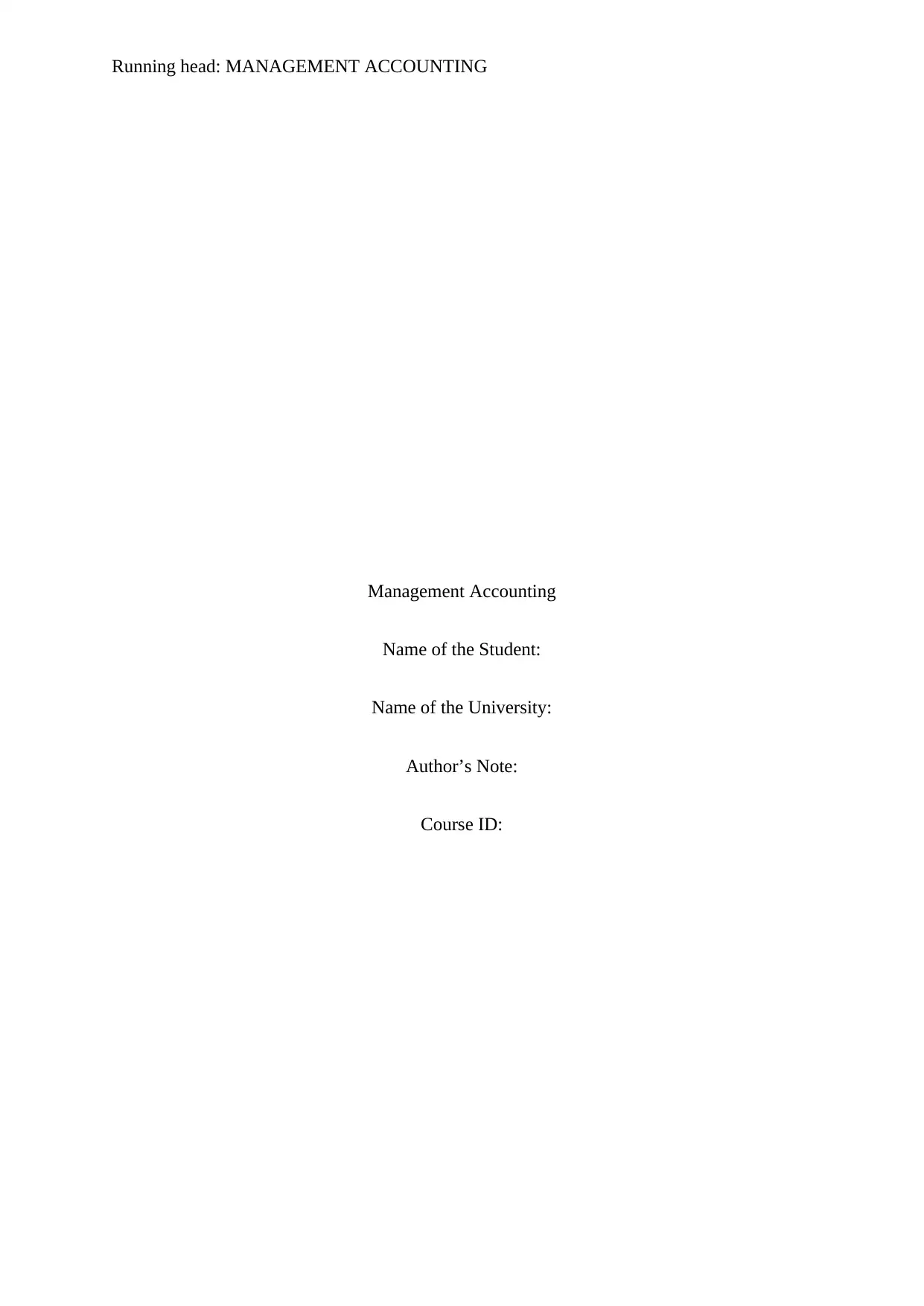
Running head: MANAGEMENT ACCOUNTING
Management Accounting
Name of the Student:
Name of the University:
Author’s Note:
Course ID:
Management Accounting
Name of the Student:
Name of the University:
Author’s Note:
Course ID:
Paraphrase This Document
Need a fresh take? Get an instant paraphrase of this document with our AI Paraphraser
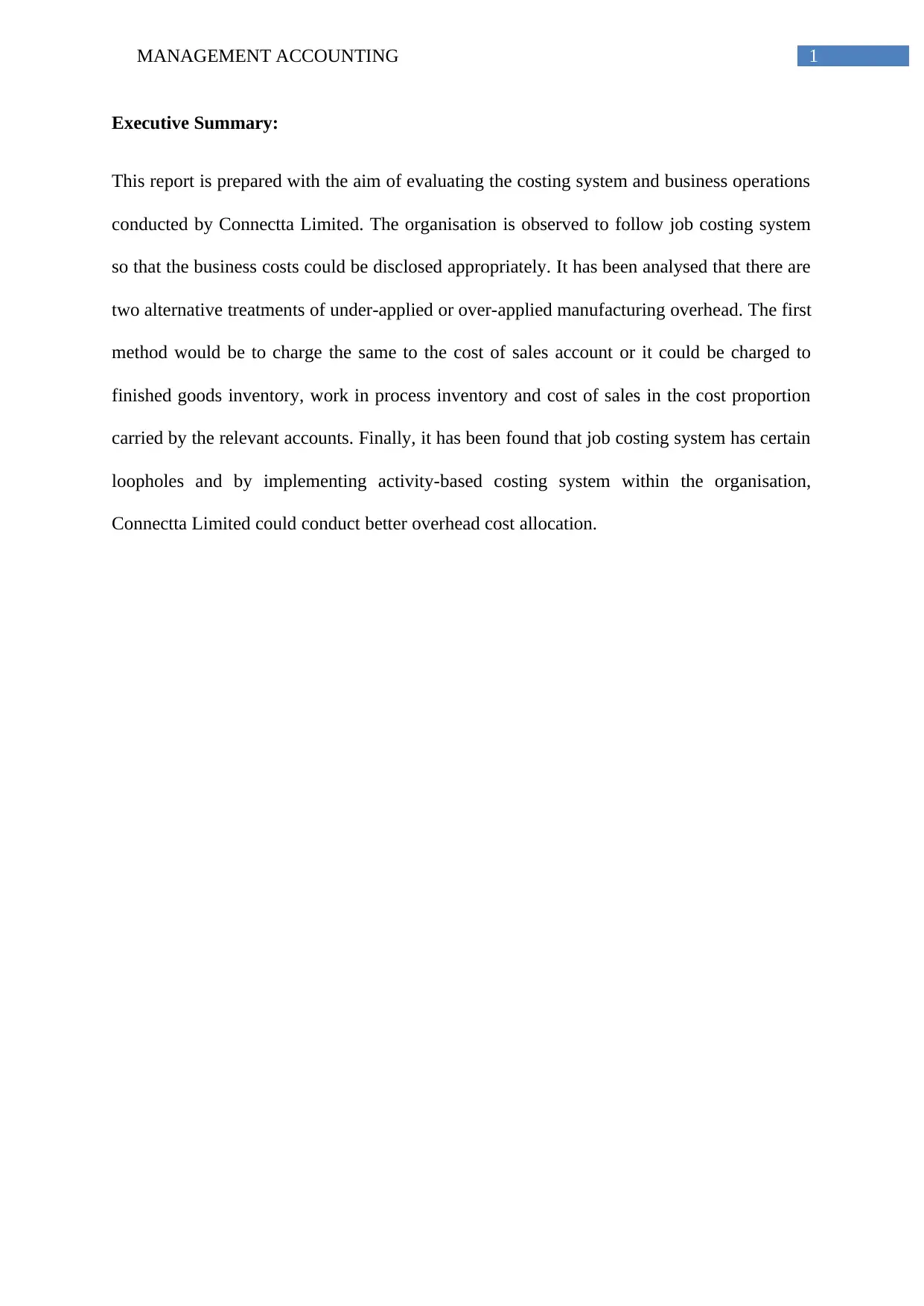
1MANAGEMENT ACCOUNTING
Executive Summary:
This report is prepared with the aim of evaluating the costing system and business operations
conducted by Connectta Limited. The organisation is observed to follow job costing system
so that the business costs could be disclosed appropriately. It has been analysed that there are
two alternative treatments of under-applied or over-applied manufacturing overhead. The first
method would be to charge the same to the cost of sales account or it could be charged to
finished goods inventory, work in process inventory and cost of sales in the cost proportion
carried by the relevant accounts. Finally, it has been found that job costing system has certain
loopholes and by implementing activity-based costing system within the organisation,
Connectta Limited could conduct better overhead cost allocation.
Executive Summary:
This report is prepared with the aim of evaluating the costing system and business operations
conducted by Connectta Limited. The organisation is observed to follow job costing system
so that the business costs could be disclosed appropriately. It has been analysed that there are
two alternative treatments of under-applied or over-applied manufacturing overhead. The first
method would be to charge the same to the cost of sales account or it could be charged to
finished goods inventory, work in process inventory and cost of sales in the cost proportion
carried by the relevant accounts. Finally, it has been found that job costing system has certain
loopholes and by implementing activity-based costing system within the organisation,
Connectta Limited could conduct better overhead cost allocation.
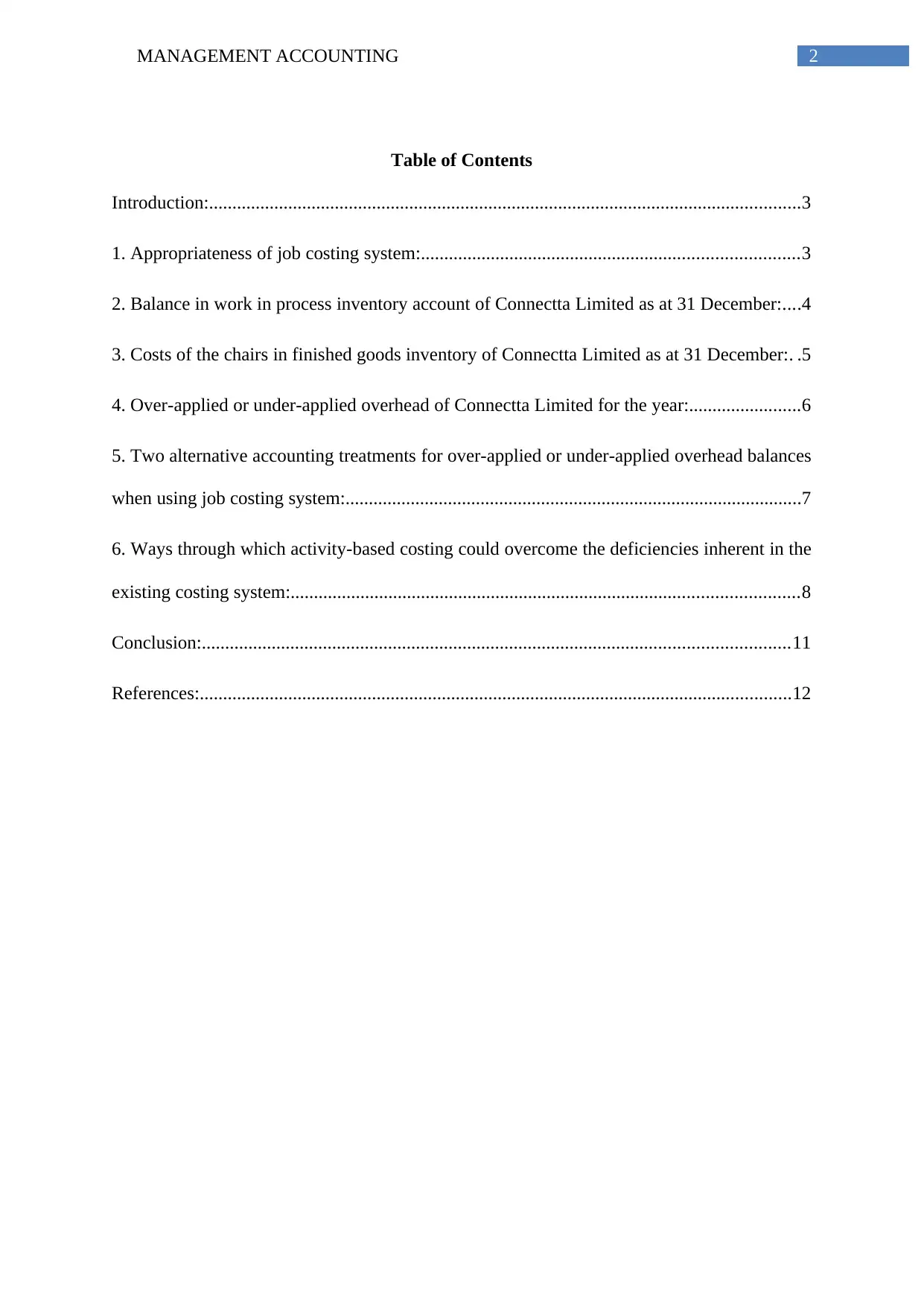
2MANAGEMENT ACCOUNTING
Table of Contents
Introduction:...............................................................................................................................3
1. Appropriateness of job costing system:.................................................................................3
2. Balance in work in process inventory account of Connectta Limited as at 31 December:....4
3. Costs of the chairs in finished goods inventory of Connectta Limited as at 31 December:. .5
4. Over-applied or under-applied overhead of Connectta Limited for the year:........................6
5. Two alternative accounting treatments for over-applied or under-applied overhead balances
when using job costing system:..................................................................................................7
6. Ways through which activity-based costing could overcome the deficiencies inherent in the
existing costing system:.............................................................................................................8
Conclusion:..............................................................................................................................11
References:...............................................................................................................................12
Table of Contents
Introduction:...............................................................................................................................3
1. Appropriateness of job costing system:.................................................................................3
2. Balance in work in process inventory account of Connectta Limited as at 31 December:....4
3. Costs of the chairs in finished goods inventory of Connectta Limited as at 31 December:. .5
4. Over-applied or under-applied overhead of Connectta Limited for the year:........................6
5. Two alternative accounting treatments for over-applied or under-applied overhead balances
when using job costing system:..................................................................................................7
6. Ways through which activity-based costing could overcome the deficiencies inherent in the
existing costing system:.............................................................................................................8
Conclusion:..............................................................................................................................11
References:...............................................................................................................................12
⊘ This is a preview!⊘
Do you want full access?
Subscribe today to unlock all pages.

Trusted by 1+ million students worldwide
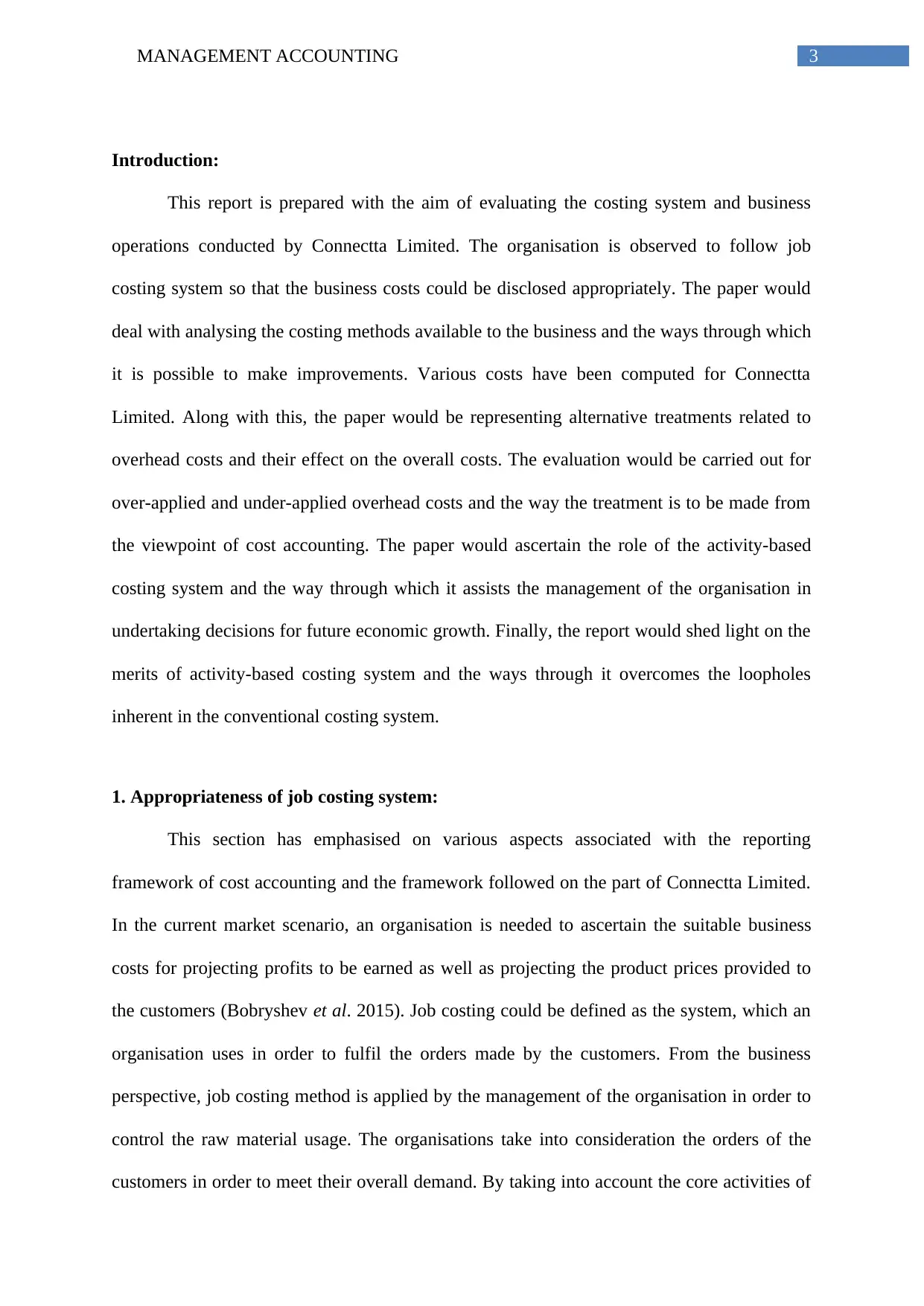
3MANAGEMENT ACCOUNTING
Introduction:
This report is prepared with the aim of evaluating the costing system and business
operations conducted by Connectta Limited. The organisation is observed to follow job
costing system so that the business costs could be disclosed appropriately. The paper would
deal with analysing the costing methods available to the business and the ways through which
it is possible to make improvements. Various costs have been computed for Connectta
Limited. Along with this, the paper would be representing alternative treatments related to
overhead costs and their effect on the overall costs. The evaluation would be carried out for
over-applied and under-applied overhead costs and the way the treatment is to be made from
the viewpoint of cost accounting. The paper would ascertain the role of the activity-based
costing system and the way through which it assists the management of the organisation in
undertaking decisions for future economic growth. Finally, the report would shed light on the
merits of activity-based costing system and the ways through it overcomes the loopholes
inherent in the conventional costing system.
1. Appropriateness of job costing system:
This section has emphasised on various aspects associated with the reporting
framework of cost accounting and the framework followed on the part of Connectta Limited.
In the current market scenario, an organisation is needed to ascertain the suitable business
costs for projecting profits to be earned as well as projecting the product prices provided to
the customers (Bobryshev et al. 2015). Job costing could be defined as the system, which an
organisation uses in order to fulfil the orders made by the customers. From the business
perspective, job costing method is applied by the management of the organisation in order to
control the raw material usage. The organisations take into consideration the orders of the
customers in order to meet their overall demand. By taking into account the core activities of
Introduction:
This report is prepared with the aim of evaluating the costing system and business
operations conducted by Connectta Limited. The organisation is observed to follow job
costing system so that the business costs could be disclosed appropriately. The paper would
deal with analysing the costing methods available to the business and the ways through which
it is possible to make improvements. Various costs have been computed for Connectta
Limited. Along with this, the paper would be representing alternative treatments related to
overhead costs and their effect on the overall costs. The evaluation would be carried out for
over-applied and under-applied overhead costs and the way the treatment is to be made from
the viewpoint of cost accounting. The paper would ascertain the role of the activity-based
costing system and the way through which it assists the management of the organisation in
undertaking decisions for future economic growth. Finally, the report would shed light on the
merits of activity-based costing system and the ways through it overcomes the loopholes
inherent in the conventional costing system.
1. Appropriateness of job costing system:
This section has emphasised on various aspects associated with the reporting
framework of cost accounting and the framework followed on the part of Connectta Limited.
In the current market scenario, an organisation is needed to ascertain the suitable business
costs for projecting profits to be earned as well as projecting the product prices provided to
the customers (Bobryshev et al. 2015). Job costing could be defined as the system, which an
organisation uses in order to fulfil the orders made by the customers. From the business
perspective, job costing method is applied by the management of the organisation in order to
control the raw material usage. The organisations take into consideration the orders of the
customers in order to meet their overall demand. By taking into account the core activities of
Paraphrase This Document
Need a fresh take? Get an instant paraphrase of this document with our AI Paraphraser
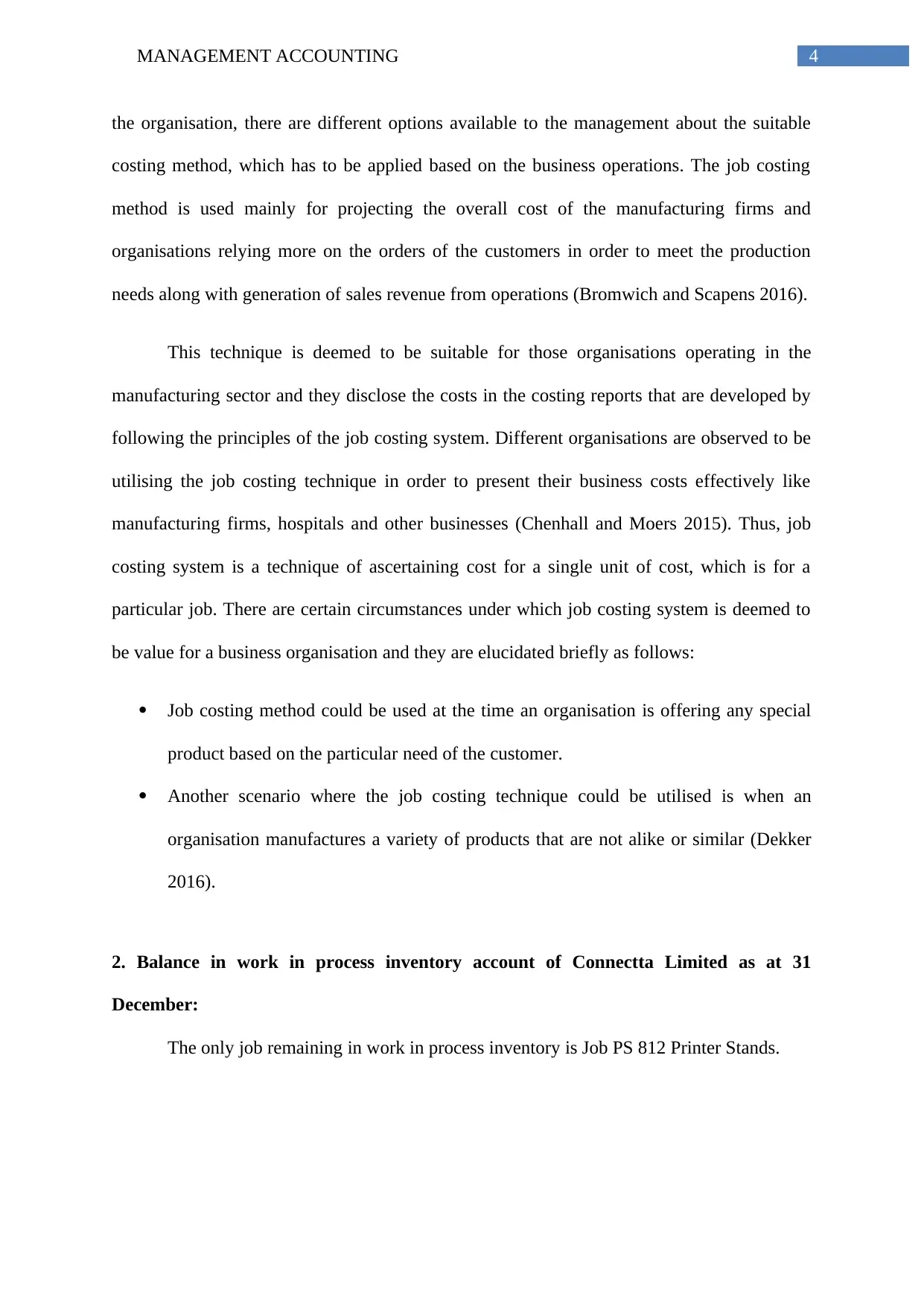
4MANAGEMENT ACCOUNTING
the organisation, there are different options available to the management about the suitable
costing method, which has to be applied based on the business operations. The job costing
method is used mainly for projecting the overall cost of the manufacturing firms and
organisations relying more on the orders of the customers in order to meet the production
needs along with generation of sales revenue from operations (Bromwich and Scapens 2016).
This technique is deemed to be suitable for those organisations operating in the
manufacturing sector and they disclose the costs in the costing reports that are developed by
following the principles of the job costing system. Different organisations are observed to be
utilising the job costing technique in order to present their business costs effectively like
manufacturing firms, hospitals and other businesses (Chenhall and Moers 2015). Thus, job
costing system is a technique of ascertaining cost for a single unit of cost, which is for a
particular job. There are certain circumstances under which job costing system is deemed to
be value for a business organisation and they are elucidated briefly as follows:
Job costing method could be used at the time an organisation is offering any special
product based on the particular need of the customer.
Another scenario where the job costing technique could be utilised is when an
organisation manufactures a variety of products that are not alike or similar (Dekker
2016).
2. Balance in work in process inventory account of Connectta Limited as at 31
December:
The only job remaining in work in process inventory is Job PS 812 Printer Stands.
the organisation, there are different options available to the management about the suitable
costing method, which has to be applied based on the business operations. The job costing
method is used mainly for projecting the overall cost of the manufacturing firms and
organisations relying more on the orders of the customers in order to meet the production
needs along with generation of sales revenue from operations (Bromwich and Scapens 2016).
This technique is deemed to be suitable for those organisations operating in the
manufacturing sector and they disclose the costs in the costing reports that are developed by
following the principles of the job costing system. Different organisations are observed to be
utilising the job costing technique in order to present their business costs effectively like
manufacturing firms, hospitals and other businesses (Chenhall and Moers 2015). Thus, job
costing system is a technique of ascertaining cost for a single unit of cost, which is for a
particular job. There are certain circumstances under which job costing system is deemed to
be value for a business organisation and they are elucidated briefly as follows:
Job costing method could be used at the time an organisation is offering any special
product based on the particular need of the customer.
Another scenario where the job costing technique could be utilised is when an
organisation manufactures a variety of products that are not alike or similar (Dekker
2016).
2. Balance in work in process inventory account of Connectta Limited as at 31
December:
The only job remaining in work in process inventory is Job PS 812 Printer Stands.
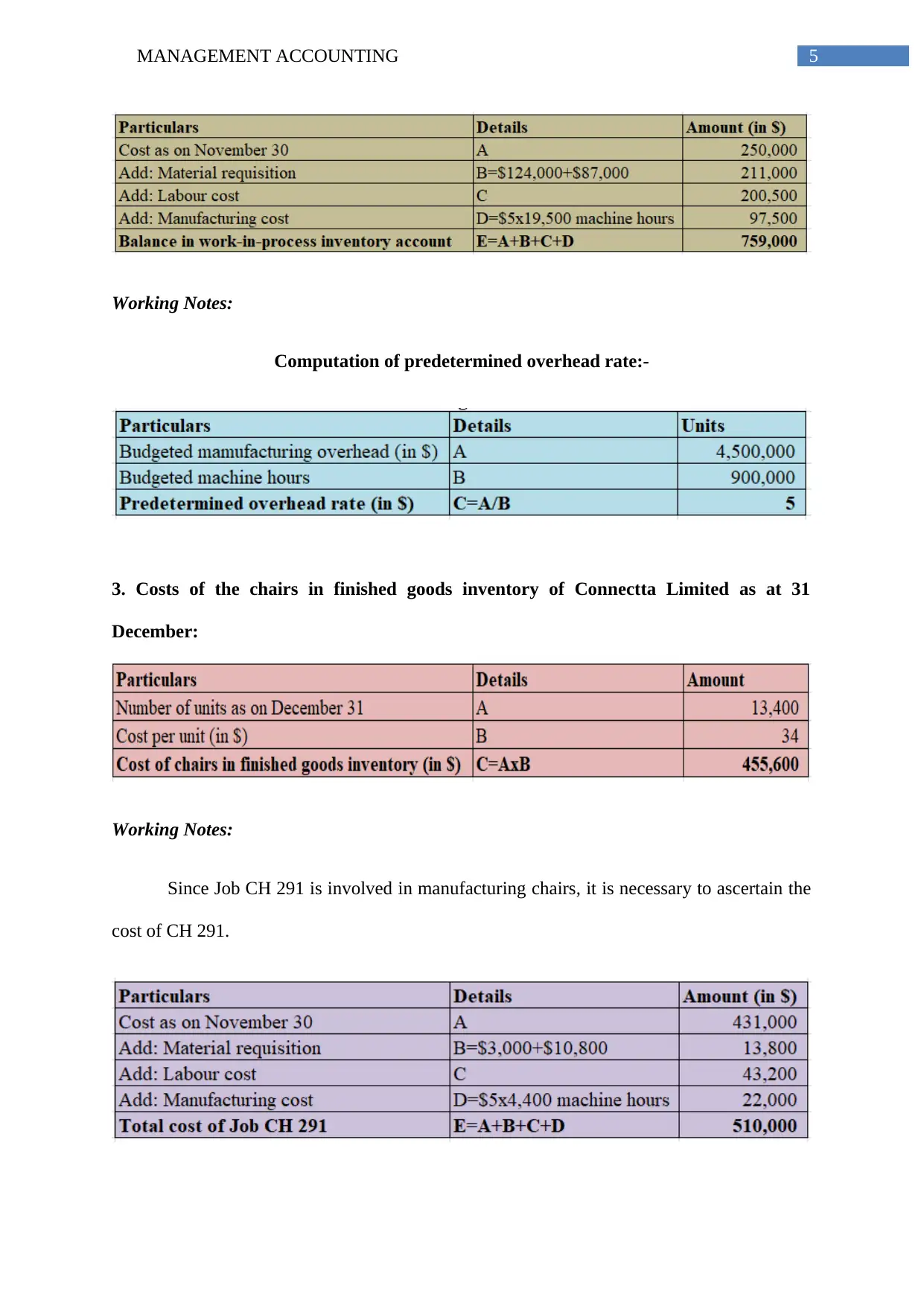
5MANAGEMENT ACCOUNTING
Working Notes:
Computation of predetermined overhead rate:-
3. Costs of the chairs in finished goods inventory of Connectta Limited as at 31
December:
Working Notes:
Since Job CH 291 is involved in manufacturing chairs, it is necessary to ascertain the
cost of CH 291.
Working Notes:
Computation of predetermined overhead rate:-
3. Costs of the chairs in finished goods inventory of Connectta Limited as at 31
December:
Working Notes:
Since Job CH 291 is involved in manufacturing chairs, it is necessary to ascertain the
cost of CH 291.
⊘ This is a preview!⊘
Do you want full access?
Subscribe today to unlock all pages.

Trusted by 1+ million students worldwide
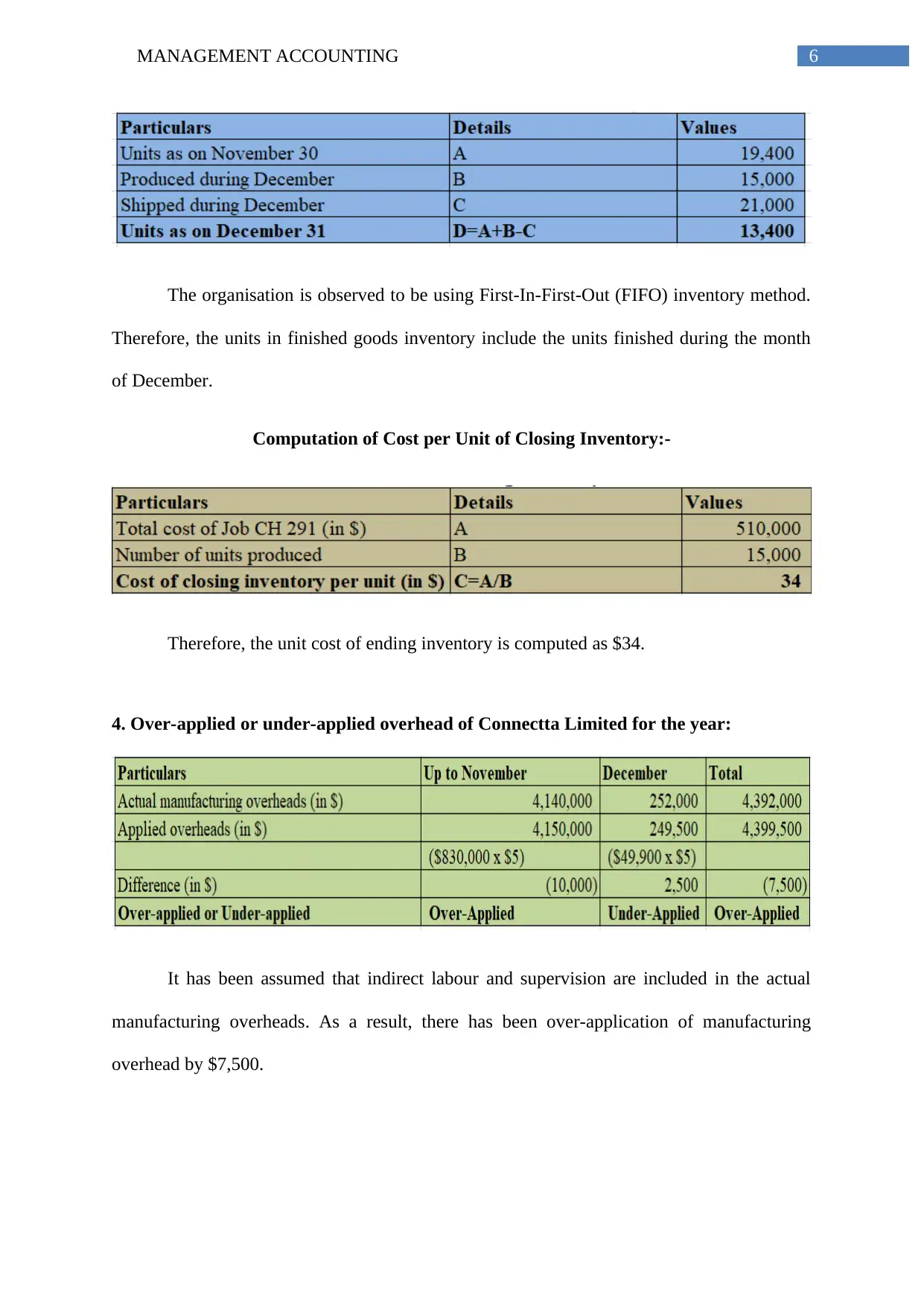
6MANAGEMENT ACCOUNTING
The organisation is observed to be using First-In-First-Out (FIFO) inventory method.
Therefore, the units in finished goods inventory include the units finished during the month
of December.
Computation of Cost per Unit of Closing Inventory:-
Therefore, the unit cost of ending inventory is computed as $34.
4. Over-applied or under-applied overhead of Connectta Limited for the year:
It has been assumed that indirect labour and supervision are included in the actual
manufacturing overheads. As a result, there has been over-application of manufacturing
overhead by $7,500.
The organisation is observed to be using First-In-First-Out (FIFO) inventory method.
Therefore, the units in finished goods inventory include the units finished during the month
of December.
Computation of Cost per Unit of Closing Inventory:-
Therefore, the unit cost of ending inventory is computed as $34.
4. Over-applied or under-applied overhead of Connectta Limited for the year:
It has been assumed that indirect labour and supervision are included in the actual
manufacturing overheads. As a result, there has been over-application of manufacturing
overhead by $7,500.
Paraphrase This Document
Need a fresh take? Get an instant paraphrase of this document with our AI Paraphraser
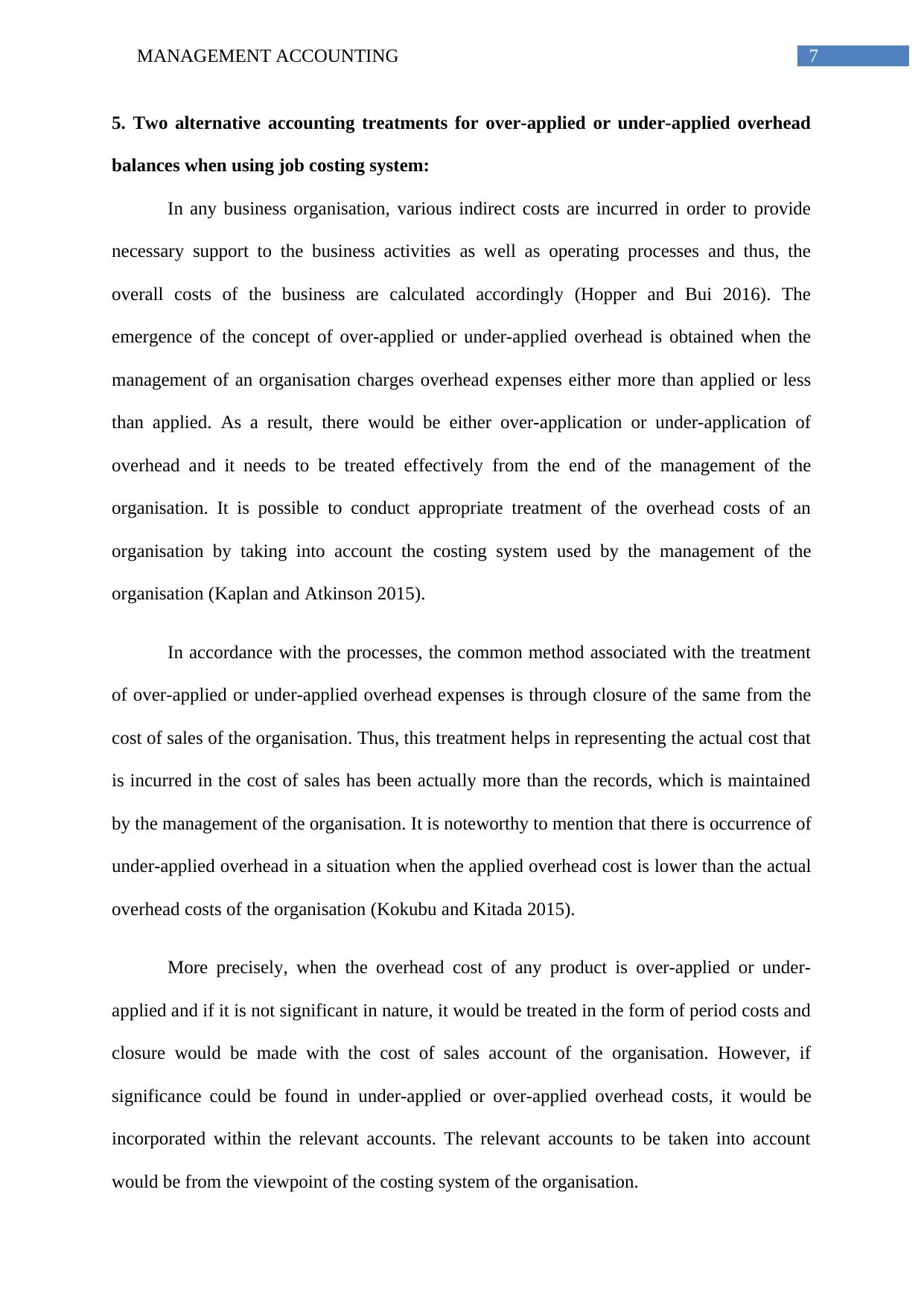
7MANAGEMENT ACCOUNTING
5. Two alternative accounting treatments for over-applied or under-applied overhead
balances when using job costing system:
In any business organisation, various indirect costs are incurred in order to provide
necessary support to the business activities as well as operating processes and thus, the
overall costs of the business are calculated accordingly (Hopper and Bui 2016). The
emergence of the concept of over-applied or under-applied overhead is obtained when the
management of an organisation charges overhead expenses either more than applied or less
than applied. As a result, there would be either over-application or under-application of
overhead and it needs to be treated effectively from the end of the management of the
organisation. It is possible to conduct appropriate treatment of the overhead costs of an
organisation by taking into account the costing system used by the management of the
organisation (Kaplan and Atkinson 2015).
In accordance with the processes, the common method associated with the treatment
of over-applied or under-applied overhead expenses is through closure of the same from the
cost of sales of the organisation. Thus, this treatment helps in representing the actual cost that
is incurred in the cost of sales has been actually more than the records, which is maintained
by the management of the organisation. It is noteworthy to mention that there is occurrence of
under-applied overhead in a situation when the applied overhead cost is lower than the actual
overhead costs of the organisation (Kokubu and Kitada 2015).
More precisely, when the overhead cost of any product is over-applied or under-
applied and if it is not significant in nature, it would be treated in the form of period costs and
closure would be made with the cost of sales account of the organisation. However, if
significance could be found in under-applied or over-applied overhead costs, it would be
incorporated within the relevant accounts. The relevant accounts to be taken into account
would be from the viewpoint of the costing system of the organisation.
5. Two alternative accounting treatments for over-applied or under-applied overhead
balances when using job costing system:
In any business organisation, various indirect costs are incurred in order to provide
necessary support to the business activities as well as operating processes and thus, the
overall costs of the business are calculated accordingly (Hopper and Bui 2016). The
emergence of the concept of over-applied or under-applied overhead is obtained when the
management of an organisation charges overhead expenses either more than applied or less
than applied. As a result, there would be either over-application or under-application of
overhead and it needs to be treated effectively from the end of the management of the
organisation. It is possible to conduct appropriate treatment of the overhead costs of an
organisation by taking into account the costing system used by the management of the
organisation (Kaplan and Atkinson 2015).
In accordance with the processes, the common method associated with the treatment
of over-applied or under-applied overhead expenses is through closure of the same from the
cost of sales of the organisation. Thus, this treatment helps in representing the actual cost that
is incurred in the cost of sales has been actually more than the records, which is maintained
by the management of the organisation. It is noteworthy to mention that there is occurrence of
under-applied overhead in a situation when the applied overhead cost is lower than the actual
overhead costs of the organisation (Kokubu and Kitada 2015).
More precisely, when the overhead cost of any product is over-applied or under-
applied and if it is not significant in nature, it would be treated in the form of period costs and
closure would be made with the cost of sales account of the organisation. However, if
significance could be found in under-applied or over-applied overhead costs, it would be
incorporated within the relevant accounts. The relevant accounts to be taken into account
would be from the viewpoint of the costing system of the organisation.
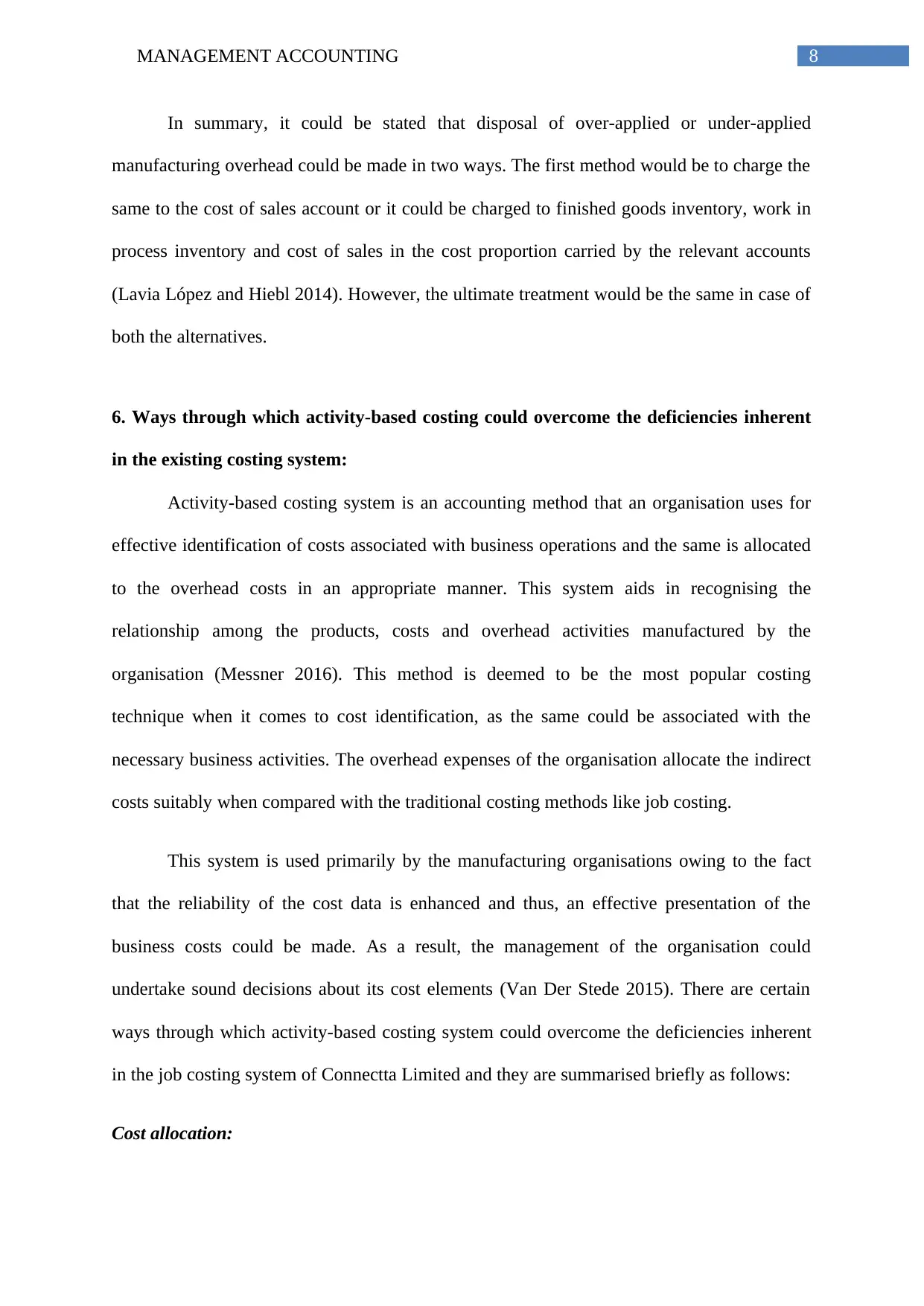
8MANAGEMENT ACCOUNTING
In summary, it could be stated that disposal of over-applied or under-applied
manufacturing overhead could be made in two ways. The first method would be to charge the
same to the cost of sales account or it could be charged to finished goods inventory, work in
process inventory and cost of sales in the cost proportion carried by the relevant accounts
(Lavia López and Hiebl 2014). However, the ultimate treatment would be the same in case of
both the alternatives.
6. Ways through which activity-based costing could overcome the deficiencies inherent
in the existing costing system:
Activity-based costing system is an accounting method that an organisation uses for
effective identification of costs associated with business operations and the same is allocated
to the overhead costs in an appropriate manner. This system aids in recognising the
relationship among the products, costs and overhead activities manufactured by the
organisation (Messner 2016). This method is deemed to be the most popular costing
technique when it comes to cost identification, as the same could be associated with the
necessary business activities. The overhead expenses of the organisation allocate the indirect
costs suitably when compared with the traditional costing methods like job costing.
This system is used primarily by the manufacturing organisations owing to the fact
that the reliability of the cost data is enhanced and thus, an effective presentation of the
business costs could be made. As a result, the management of the organisation could
undertake sound decisions about its cost elements (Van Der Stede 2015). There are certain
ways through which activity-based costing system could overcome the deficiencies inherent
in the job costing system of Connectta Limited and they are summarised briefly as follows:
Cost allocation:
In summary, it could be stated that disposal of over-applied or under-applied
manufacturing overhead could be made in two ways. The first method would be to charge the
same to the cost of sales account or it could be charged to finished goods inventory, work in
process inventory and cost of sales in the cost proportion carried by the relevant accounts
(Lavia López and Hiebl 2014). However, the ultimate treatment would be the same in case of
both the alternatives.
6. Ways through which activity-based costing could overcome the deficiencies inherent
in the existing costing system:
Activity-based costing system is an accounting method that an organisation uses for
effective identification of costs associated with business operations and the same is allocated
to the overhead costs in an appropriate manner. This system aids in recognising the
relationship among the products, costs and overhead activities manufactured by the
organisation (Messner 2016). This method is deemed to be the most popular costing
technique when it comes to cost identification, as the same could be associated with the
necessary business activities. The overhead expenses of the organisation allocate the indirect
costs suitably when compared with the traditional costing methods like job costing.
This system is used primarily by the manufacturing organisations owing to the fact
that the reliability of the cost data is enhanced and thus, an effective presentation of the
business costs could be made. As a result, the management of the organisation could
undertake sound decisions about its cost elements (Van Der Stede 2015). There are certain
ways through which activity-based costing system could overcome the deficiencies inherent
in the job costing system of Connectta Limited and they are summarised briefly as follows:
Cost allocation:
⊘ This is a preview!⊘
Do you want full access?
Subscribe today to unlock all pages.

Trusted by 1+ million students worldwide
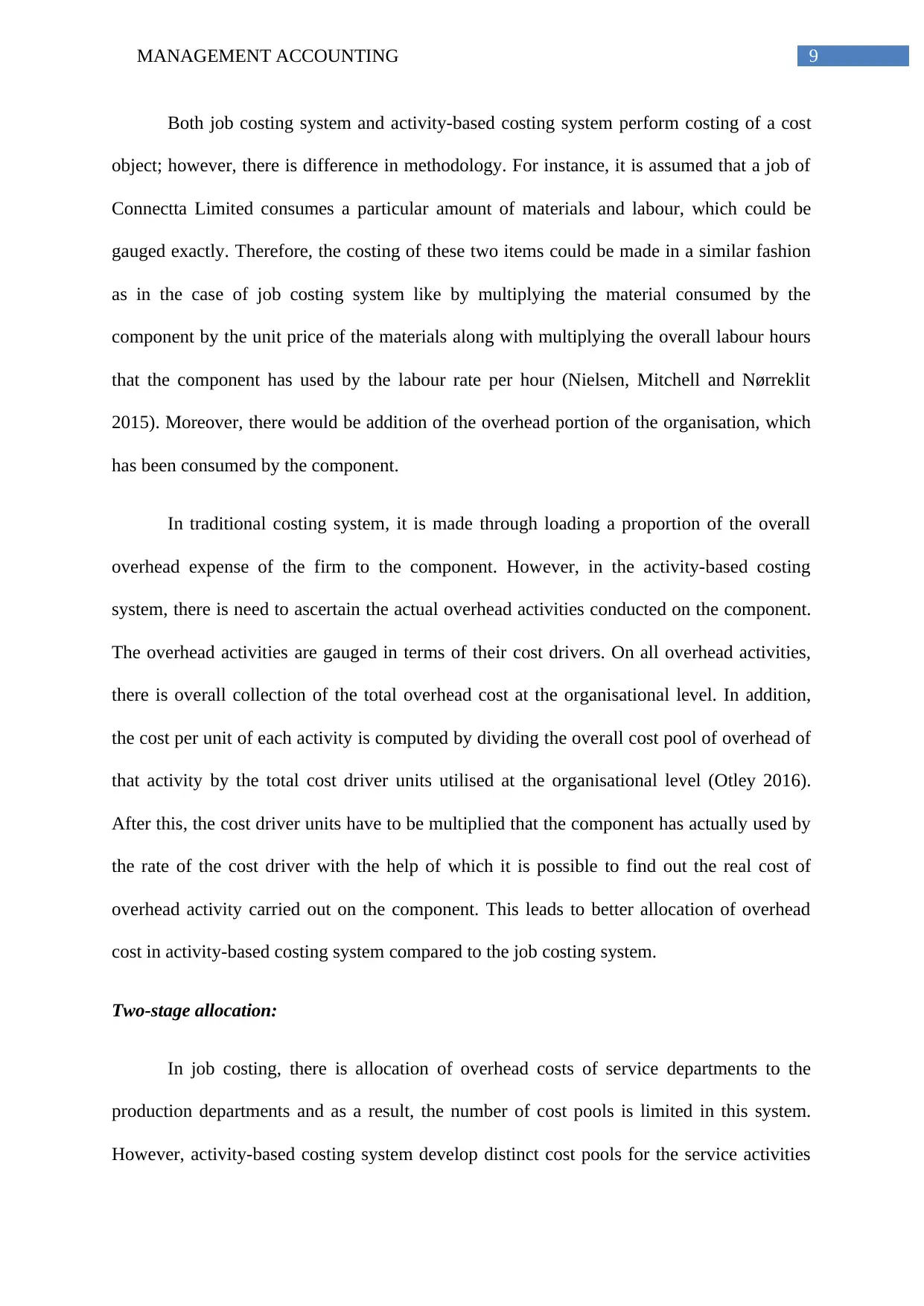
9MANAGEMENT ACCOUNTING
Both job costing system and activity-based costing system perform costing of a cost
object; however, there is difference in methodology. For instance, it is assumed that a job of
Connectta Limited consumes a particular amount of materials and labour, which could be
gauged exactly. Therefore, the costing of these two items could be made in a similar fashion
as in the case of job costing system like by multiplying the material consumed by the
component by the unit price of the materials along with multiplying the overall labour hours
that the component has used by the labour rate per hour (Nielsen, Mitchell and Nørreklit
2015). Moreover, there would be addition of the overhead portion of the organisation, which
has been consumed by the component.
In traditional costing system, it is made through loading a proportion of the overall
overhead expense of the firm to the component. However, in the activity-based costing
system, there is need to ascertain the actual overhead activities conducted on the component.
The overhead activities are gauged in terms of their cost drivers. On all overhead activities,
there is overall collection of the total overhead cost at the organisational level. In addition,
the cost per unit of each activity is computed by dividing the overall cost pool of overhead of
that activity by the total cost driver units utilised at the organisational level (Otley 2016).
After this, the cost driver units have to be multiplied that the component has actually used by
the rate of the cost driver with the help of which it is possible to find out the real cost of
overhead activity carried out on the component. This leads to better allocation of overhead
cost in activity-based costing system compared to the job costing system.
Two-stage allocation:
In job costing, there is allocation of overhead costs of service departments to the
production departments and as a result, the number of cost pools is limited in this system.
However, activity-based costing system develop distinct cost pools for the service activities
Both job costing system and activity-based costing system perform costing of a cost
object; however, there is difference in methodology. For instance, it is assumed that a job of
Connectta Limited consumes a particular amount of materials and labour, which could be
gauged exactly. Therefore, the costing of these two items could be made in a similar fashion
as in the case of job costing system like by multiplying the material consumed by the
component by the unit price of the materials along with multiplying the overall labour hours
that the component has used by the labour rate per hour (Nielsen, Mitchell and Nørreklit
2015). Moreover, there would be addition of the overhead portion of the organisation, which
has been consumed by the component.
In traditional costing system, it is made through loading a proportion of the overall
overhead expense of the firm to the component. However, in the activity-based costing
system, there is need to ascertain the actual overhead activities conducted on the component.
The overhead activities are gauged in terms of their cost drivers. On all overhead activities,
there is overall collection of the total overhead cost at the organisational level. In addition,
the cost per unit of each activity is computed by dividing the overall cost pool of overhead of
that activity by the total cost driver units utilised at the organisational level (Otley 2016).
After this, the cost driver units have to be multiplied that the component has actually used by
the rate of the cost driver with the help of which it is possible to find out the real cost of
overhead activity carried out on the component. This leads to better allocation of overhead
cost in activity-based costing system compared to the job costing system.
Two-stage allocation:
In job costing, there is allocation of overhead costs of service departments to the
production departments and as a result, the number of cost pools is limited in this system.
However, activity-based costing system develop distinct cost pools for the service activities
Paraphrase This Document
Need a fresh take? Get an instant paraphrase of this document with our AI Paraphraser
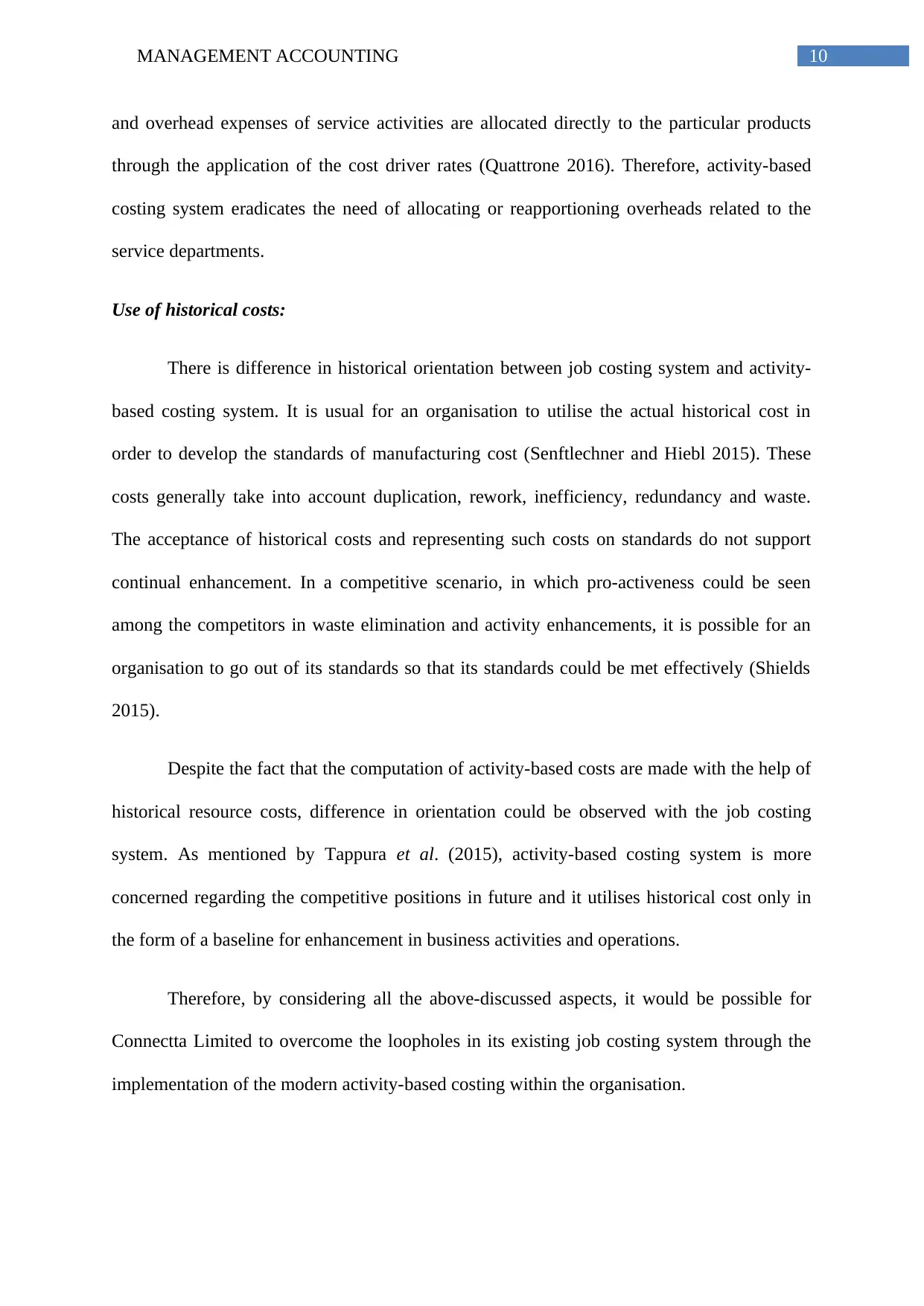
10MANAGEMENT ACCOUNTING
and overhead expenses of service activities are allocated directly to the particular products
through the application of the cost driver rates (Quattrone 2016). Therefore, activity-based
costing system eradicates the need of allocating or reapportioning overheads related to the
service departments.
Use of historical costs:
There is difference in historical orientation between job costing system and activity-
based costing system. It is usual for an organisation to utilise the actual historical cost in
order to develop the standards of manufacturing cost (Senftlechner and Hiebl 2015). These
costs generally take into account duplication, rework, inefficiency, redundancy and waste.
The acceptance of historical costs and representing such costs on standards do not support
continual enhancement. In a competitive scenario, in which pro-activeness could be seen
among the competitors in waste elimination and activity enhancements, it is possible for an
organisation to go out of its standards so that its standards could be met effectively (Shields
2015).
Despite the fact that the computation of activity-based costs are made with the help of
historical resource costs, difference in orientation could be observed with the job costing
system. As mentioned by Tappura et al. (2015), activity-based costing system is more
concerned regarding the competitive positions in future and it utilises historical cost only in
the form of a baseline for enhancement in business activities and operations.
Therefore, by considering all the above-discussed aspects, it would be possible for
Connectta Limited to overcome the loopholes in its existing job costing system through the
implementation of the modern activity-based costing within the organisation.
and overhead expenses of service activities are allocated directly to the particular products
through the application of the cost driver rates (Quattrone 2016). Therefore, activity-based
costing system eradicates the need of allocating or reapportioning overheads related to the
service departments.
Use of historical costs:
There is difference in historical orientation between job costing system and activity-
based costing system. It is usual for an organisation to utilise the actual historical cost in
order to develop the standards of manufacturing cost (Senftlechner and Hiebl 2015). These
costs generally take into account duplication, rework, inefficiency, redundancy and waste.
The acceptance of historical costs and representing such costs on standards do not support
continual enhancement. In a competitive scenario, in which pro-activeness could be seen
among the competitors in waste elimination and activity enhancements, it is possible for an
organisation to go out of its standards so that its standards could be met effectively (Shields
2015).
Despite the fact that the computation of activity-based costs are made with the help of
historical resource costs, difference in orientation could be observed with the job costing
system. As mentioned by Tappura et al. (2015), activity-based costing system is more
concerned regarding the competitive positions in future and it utilises historical cost only in
the form of a baseline for enhancement in business activities and operations.
Therefore, by considering all the above-discussed aspects, it would be possible for
Connectta Limited to overcome the loopholes in its existing job costing system through the
implementation of the modern activity-based costing within the organisation.
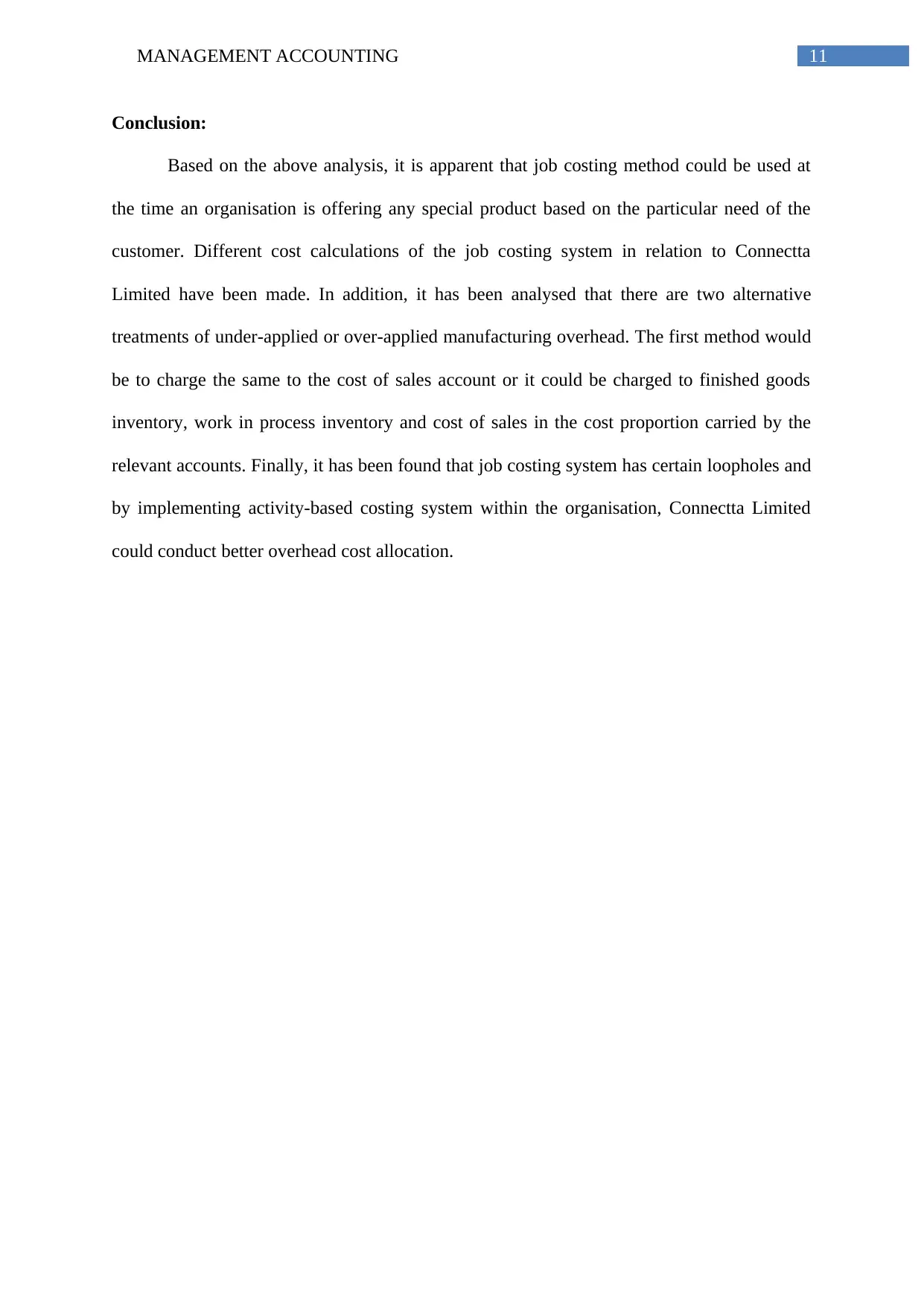
11MANAGEMENT ACCOUNTING
Conclusion:
Based on the above analysis, it is apparent that job costing method could be used at
the time an organisation is offering any special product based on the particular need of the
customer. Different cost calculations of the job costing system in relation to Connectta
Limited have been made. In addition, it has been analysed that there are two alternative
treatments of under-applied or over-applied manufacturing overhead. The first method would
be to charge the same to the cost of sales account or it could be charged to finished goods
inventory, work in process inventory and cost of sales in the cost proportion carried by the
relevant accounts. Finally, it has been found that job costing system has certain loopholes and
by implementing activity-based costing system within the organisation, Connectta Limited
could conduct better overhead cost allocation.
Conclusion:
Based on the above analysis, it is apparent that job costing method could be used at
the time an organisation is offering any special product based on the particular need of the
customer. Different cost calculations of the job costing system in relation to Connectta
Limited have been made. In addition, it has been analysed that there are two alternative
treatments of under-applied or over-applied manufacturing overhead. The first method would
be to charge the same to the cost of sales account or it could be charged to finished goods
inventory, work in process inventory and cost of sales in the cost proportion carried by the
relevant accounts. Finally, it has been found that job costing system has certain loopholes and
by implementing activity-based costing system within the organisation, Connectta Limited
could conduct better overhead cost allocation.
⊘ This is a preview!⊘
Do you want full access?
Subscribe today to unlock all pages.

Trusted by 1+ million students worldwide
1 out of 14
Related Documents
Your All-in-One AI-Powered Toolkit for Academic Success.
+13062052269
info@desklib.com
Available 24*7 on WhatsApp / Email
![[object Object]](/_next/static/media/star-bottom.7253800d.svg)
Unlock your academic potential
Copyright © 2020–2025 A2Z Services. All Rights Reserved. Developed and managed by ZUCOL.





